 Due to widespread plagiarism of the images from this site, without giving credit, all 3,000+ images have been watermarked with the above logo. Any images with this watermark found on other sites have been stolen!
Due to widespread plagiarism of the images from this site, without giving credit, all 3,000+ images have been watermarked with the above logo. Any images with this watermark found on other sites have been stolen!
Category: Randoms
Site Hosting
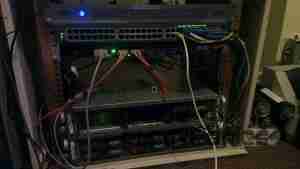
There have been quite a few updates to the hosting solution for this site, which is hosted locally in my house, from the above setup, in a small comms rack, to a new 22U half rack, with some hardware upgrades to come.
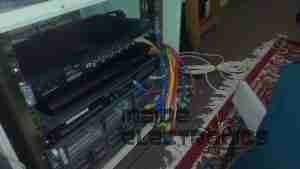
Core switch here has been removed, with the rest of the core network equipment. The site was kept online by a direct connection into the gateway to the intertubes.
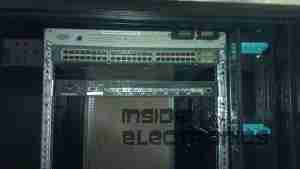
New 22U rack, with the core switch, FC switch & management & monitoring server installed.
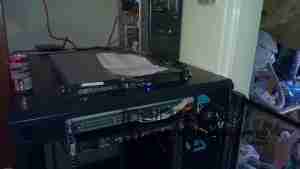
As I had no rack rails to start with, the servers were placed on the top of the rack to start off, here is the Dell PowerEdge 860 pfSense core router installed, with the initial switch wiring to get the internal core network back online. This machine load balances two connections for an aggregated bandwidth of 140MB/s downstream & 15MB/s upstream.
The tower server behind is the NAS unit that runs the backups of the main & auxiliary webservers.
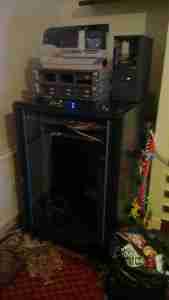
Still with no rack kits, all the servers are placed on top of the rack, before final installation. This allows running of the network before the rest of the equipment was installed.
The main server & aux server are HP ProLiant DL380 G3 servers, with redundant network connections.
Still to arrive are the final rack kits for the servers & a set of HP BL20p Blade servers, which will be running the sites in the future.
Stay tuned for more updates as they happen!
Brightwell Brightstar II BSL4 Dosing System
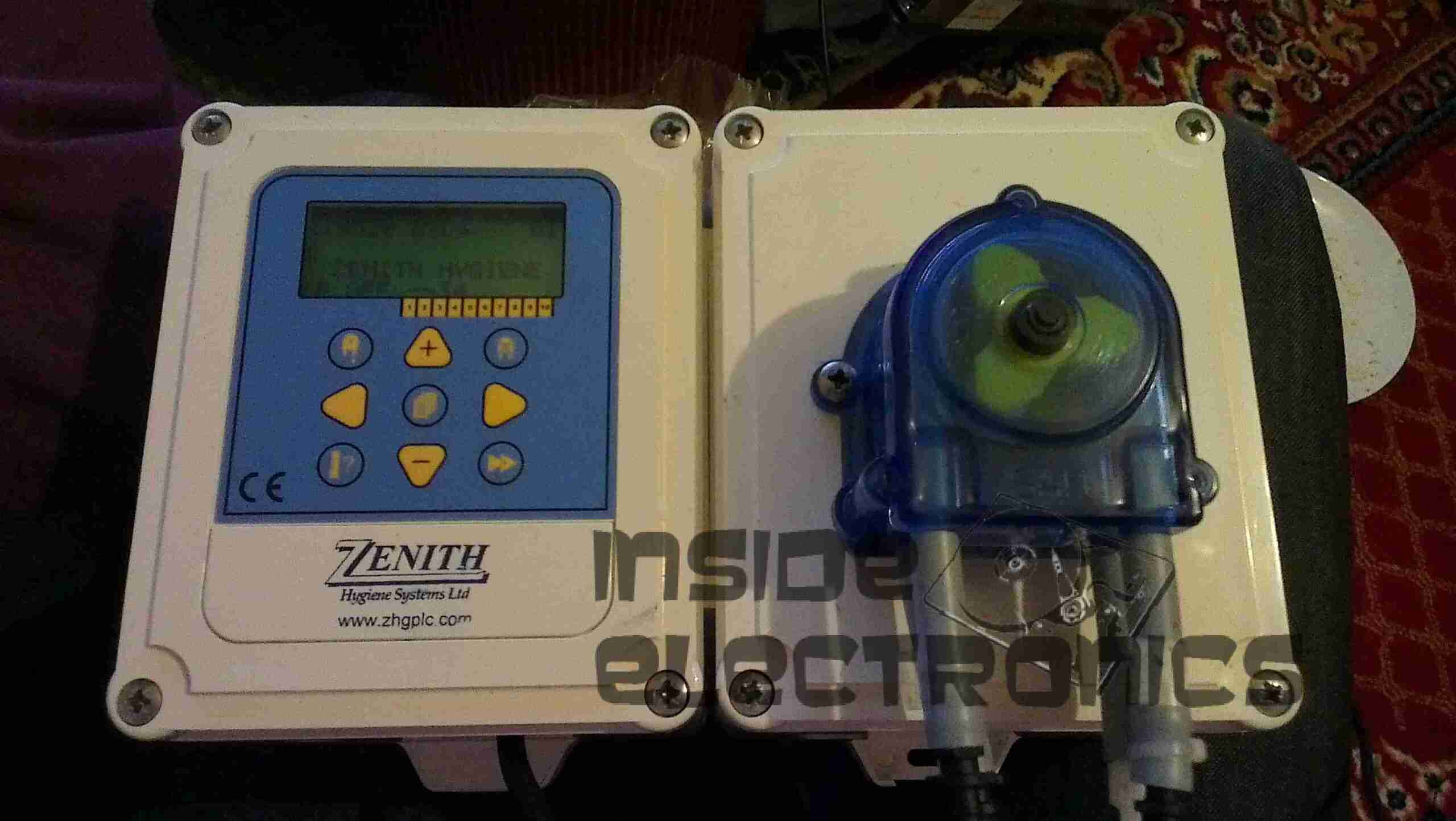
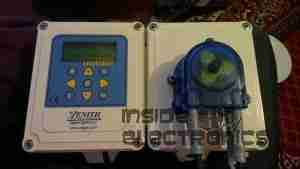
Here is an old chemical dosing system for industrial washing machines. These units are 4-pump models, with dual pumpheads. The motors are reversed to operate alternate pumps in the same head.
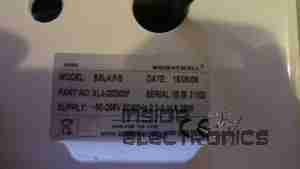
From 2006, this is a fairly old unit, and made in the UK.
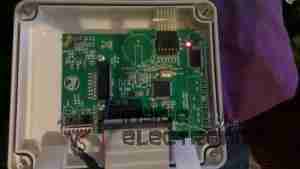
Main controller PCB, with interface to the power electronics via the ribbon cable, an external serial port for programming to it’s left. Powered by an ST microcontroller. The LCD is below this board.
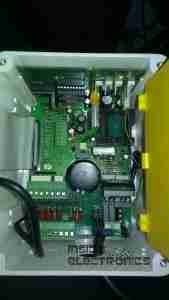
Main power supply, sense input & motor driver boards. The PSU outputs +5v, +12v & +24v. The inputs on the lower left connect to the washing machine & trigger the pumps via the programming on the CPU. The motors are driven by L6202 H-Bridge drivers from ST.
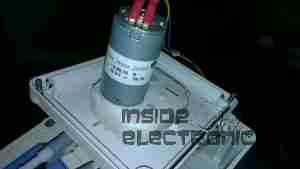
Motor & gearbox assembly on the back of the pumphead. These are 24v DC units with 80RPM gearboxes.
UPDATE:
As it seems to be difficult to find, here is the user manual for this unit:
[download id=”5557″]
Routemaster Control Unit
This is the control unit for a Routemaster system, that downloads traffic information for the area local to the vehicle.
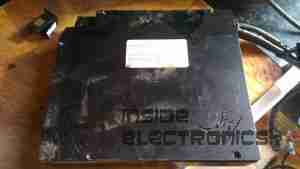
Here is an overview of the unit, in it’s aluminium box.
Here is the unit with the top cover removed, showing the pair of PCBs. The bottom PCB is the main control PCB, the top one holds an IC similar to a SIM card & part of the radio.
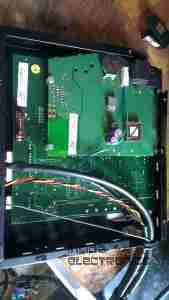
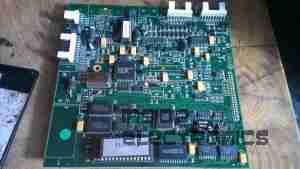
Here is the main PCB removed from the casing, contains the program ROM & microcontroller. for the system
Daughtercard view. This holds another programmed CPLD, the custom SIM-like IC & the RTC battery, along with some power conversion circuitry.

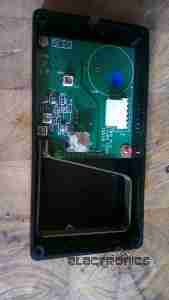
This is the radio receiver, looks to be AM, the large loop antenna can be seen at the bottom of the box.
Update!
Well things have been hectic over the past couple of months.
With a new job & a new addition to the family I’m not getting much time to update the site, however there are a few things on the way!
More Raspberry Pi stuff will be arriving soon, running the GPIO with a web interface.
I found a fault with Dell servers that I’ve managed to fix without having to replace some very expensive parts! This might be of interest to people with such servers, more info to come soon!
Vintage Optical Block
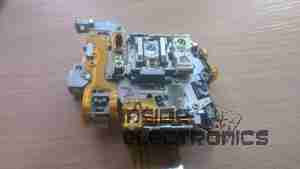
I thought this would be of interest, as it’s from a drive circa 2001, (DVD-CD-RW).
It’s the biggest & most complex optical block I’ve ever seen, with totally separate beam paths for the IR CD beam & the visible DVD beam. It also combines the use of bare laser diodes & combined diode/photodiode array modules for the pickup.
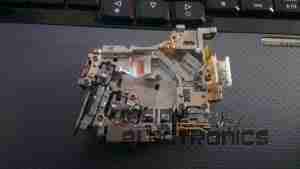
Here’s a look at the optics inside the sled, on the left is a bare laser diode & photodiode array, for the CD reading, and the bottom right has the DVD combined LD/PD array module. The beam from the CD diode has to pass though some very complex beam forming optics & a prism to fold it round to the final turning mirror to the objective lens at top center.
There are also two separate photodiodes which are picking up the waste beam from the prisms, most likely for power control.
OMXPlayer Series Play
This is a little script to make OMXPlayer on the Raspberry Pi cycle through every file in a specified folder, useful for playing sequential movies or series of episodes.
#!/bin/bash if [ x"$1" = x"help" -o x"$1" = x"--help" -o x"$1" = x"-help" ];then echo "Usage: omxseries [folder path]" echo "Audio Mode can be either 'hdmi' or 'local'." echo "Folder Path is the full path to the video files on your system." echo "This script will attempt to play every file in the target folder, with any file extension," echo "so ensure that only valid video files are present in the target folder to avoid errors." exit fi
for file in $2/* do omxplayer -o $1 $file done
Example:
[root@raspbian ~]# omxseries hdmi /media/stuff/videos
would play everything in /media/stuff/videos and send the audio over the HDMI port.
Download the script to your Pi with this code:
wget -O /usr/bin/playseries http://www.experimental-engineering.co.uk/wp-content/plugins/download-monitor/download.php?id=1 && chmod +x /usr/bin/playseries
AutoFace HID Ballast & Bulb
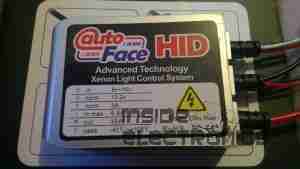
I bought one of these cheap HID kits from eBay to build a high-brightness work light that I could run from my central 12v supply.
At £14.99 I certainly wasn’t expecting anything more than the usual cheap Chinese construction. And that’s definitely what I got 😀
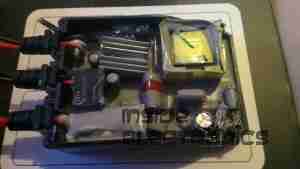
The casing is screwed together with the cheapest of screws, with heads that are deformed enough to present a problem with removal.
As can be seen here, the inside of the unit is potted in rubber compound, mostly to provide moisture resistance, as these are for automotive use.
The ballast generates a 23kV pulse to strike the arc in the bulb, then supplies a steady 85v AC at 3A, 400Hz to maintain the discharge.
This module could quite easily be depotted as the silicone material used is fairly soft & can be removed with a pointed tool.
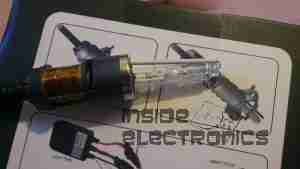
Here is the bulb removed from it’s mount. Under the bulb itself is a solenoid, which tilts the bulb by a few degrees, presumably to provide dim/dip operation for a headlight. This functionality is superfluous to my requirements.
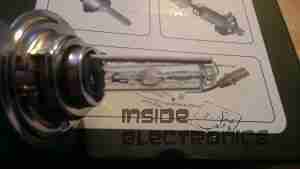
Closeup of the arc chamber of the bulb.